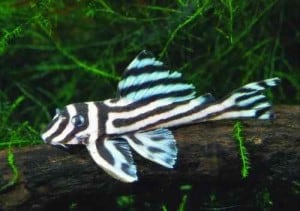
Common name: Zebra Plecostomus, L046, L98, L173
Scientific name: Hypancistrus Zebra
Average Adult Fish Size: 3 inches / 7.5 cm
Place of Origin: North East Brazil, South America.
Typical Tank setup: S. American riverine biotope with caves, rocks, driftwood, bogwood, live plants and a lot of places to hide. Good filtration and a moderate current is desired.
Recommended Minimum Aquarium Capacity: 30 gallon / 120 litre
Compatibility: Zebra plecos are not aggressive and can be kept in community aquariums with other peaceful species.
Temperature: 79 – 86 Deg F / 26 – 30 Deg C
Water chemistry: pH 6.0 – 7.5
Feeding: The Zebra Pleco is an omnivore and does not eat much algae in the wild or in the aquarium. It does best on a varied diet of wafers, pellets, and flakes designed for omnivores combined with meaty food such as brine shrimp and blood worms. Make sure that your Zebra pleco actually gets some food. They can have a hard time competing with faster species.
A good selection of food can be:
- Frozen Blood worm – preferably gamma radiated)
- Frozen Brine Shrimp – preferably Gamma radiated)
- Live Bloodworm or Brine Shrimp, – although these can carry parasites)
- Peas, – crushed with the skin removed)
- Courgette, – or as it also known Zucchini or Baby Marrows). I prefer to par boil mine just to soften them up a bit.
- Tetra Prima
- Sometimes Algae wafers
Sexing: Sexing is easiest when the fishes are viewed from above since the male has a somewhat broader head than the female. His first pectoral fin ray is also a bit thicker. When he gets into breeding condition, he will develop eye-catching bristles on this fin ray.
Breeding: 79 – 86 Deg. F / 26 – 30 degrees C is the normal temperature Zebras should be kept at, but if you want to induce breeding you should increase the temperature up to 83 – 86 Deg. F / 28 – 30 degrees C. During spawning the female will lay several batches of large white eggs inside a cave or similar while the male guards the entrance. The male will leave the entrance to fertilize the eggs, and when all batches have been laid and fertilized he will chase the female away. The eggs are cared for and guarded by the male and it is therefore very important to let him stay in the aquarium. Zebra pleco eggs normally hatch within a week and the fry will receive nutrients from their yolk sacs for another 3-4 days. It can sometimes be tricky to notice that the eggs have hatched since the fry are so small. They look almost like tiny strands of hair and are not able to swim around until they have finished their yolk sacs.
When the yolk sac has been devoured, the fry is ready to eat baby brine shrimp (BBS). You can supplement the artemia with powdered flake food. Zebra pleco fry develop noticeable striping at a very early age, often right after having consumed the yolk sac. Within a week or so, they will look like miniature copies of their parents.
When rearing Zebra pleco fry, it is extremely important to keep the oxygen content up and the levels of organic waste down. Over feeding is a common reason for foul water and must be avoided. Carry out small and frequent water changes instead of making large water changes once in a while. Another risk is the filter system. In order to prevent tiny fry from being sucked in, you can cover the opening with filter wool or something similar. Another option is to use a sponge filter for filtration.
Don’t loose heart if the first spawning does not produce any fry. It is quite common. Your fish will most likely be more successful next time.
Additional Information: The Zebra pleco is an extremely popular pleco and vast amounts of Zebra plecos used to be exported from Brazil each year. The Brazilian government feared that this harvest could be hard for the Zebra pleco populations to handle in the long run and banned the export of them completely. Since then, captive breeding of Zebra plecos outside Brazil has become very important for the hobby. Since it is such a popular fish, the fry normally sell at fairly high prices and it is definitely not hard to find buyers for them. A healthy and genetically correct Zebra should have a long nose and not a snubbed nose. Good filtration, a moderate current, and frequent partial water changes are required to keep this expensive plecostomus healthy.


Related Posts
Croaking Gourami – Trichopsis vittatus
Benthochromis Tricoti
Large-eyed Mouthbrooder – Callochromis Macrops